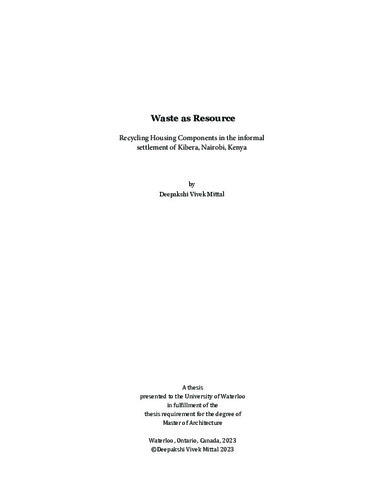| dc.contributor.author | Mittal, Deepakshi | |
| dc.date.accessioned | 2023-09-15 19:30:10 (GMT) | |
| dc.date.available | 2023-09-15 19:30:10 (GMT) | |
| dc.date.issued | 2023-09-15 | |
| dc.date.submitted | 2023-08-25 | |
| dc.identifier.uri | http://hdl.handle.net/10012/19867 | |
| dc.description.abstract | Amidst rapid urbanization, large self-built settlements such as Kibera in the capital city of Nairobi, Kenya, confront numerous environmental crises like flooding, alongside critical issues like limited nutrition, overall stability, inadequate access to potable water and essential services. Despite the challenges, the people of Kibera have demonstrated innovative practices by recycling waste and utilizing unconventional materials in their daily lives. Given the substantial movement of people and material within the settlement, this study proposes to augment architectural resilience that responds adeptly to these dynamic conditions.
This thesis focuses on investigating the materiality systems of Kibera to develop strategies that integrate architectural resilience within the informal urban fabric and its dwellings. Documentation methods such as using photographs and other digital media have been employed to effectively map the existing construction methods in neighborhoods in Kibera and highlight its distinctive features. Centering material reuse cycles and adopting a cradle-to-cradle approach, this research seeks to establish a recycling economy framework that addresses waste disposal and various stages of material usage within the settlement.
Most current building practices often result in the depletion of valuable resources, which are frequently discarded in landfills, contributing to climate crises and exacerbating rural-to-urban migration patterns. Through an in-depth exploration of discarded materials in Kibera, this thesis proposes a comprehensive and inclusive design strategy addressing multiple scales – collective, urban, individual, and semi-private, to provide better access to materials and facilities for constructing these assemblies. Envisioning a multi-faceted recycling and community Centre, it aims to inspire future development while better meeting the infrastructural needs of Kibera’s residents. | en |
| dc.language.iso | en | en |
| dc.publisher | University of Waterloo | en |
| dc.subject | Recycled Materials | en |
| dc.subject | Construction Waste | en |
| dc.subject | Informal Settlement | en |
| dc.subject | Self-help Construction | en |
| dc.subject | Kibera | en |
| dc.subject | material system | en |
| dc.subject | Recycling economy | en |
| dc.subject | Kenya | en |
| dc.subject | Informal settlement Redevelopment | en |
| dc.subject | Recycling Waste in Architecture | en |
| dc.title | Waste as Resource: Recycling housing components in the informal settlement of Kibera, Nairobi, Kenya | en |
| dc.type | Master Thesis | en |
| dc.pending | false | |
| uws-etd.degree.department | School of Architecture | en |
| uws-etd.degree.discipline | Architecture | en |
| uws-etd.degree.grantor | University of Waterloo | en |
| uws-etd.degree | Master of Architecture | en |
| uws-etd.embargo.terms | 0 | en |
| uws.contributor.advisor | Macdonald, Marie-Paule | |
| uws.contributor.affiliation1 | Faculty of Engineering | en |
| uws.published.city | Waterloo | en |
| uws.published.country | Canada | en |
| uws.published.province | Ontario | en |
| uws.typeOfResource | Text | en |
| uws.peerReviewStatus | Unreviewed | en |
| uws.scholarLevel | Graduate | en |

